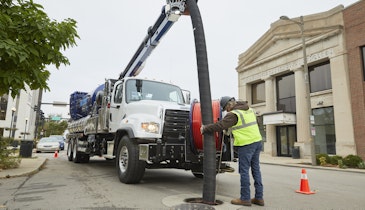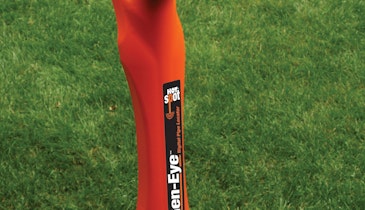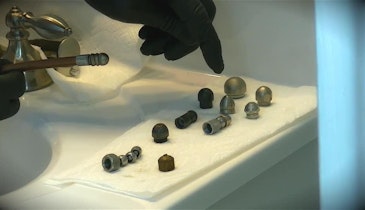You wouldn’t expect latex gloves to protect you from a gunshot. They won’t protect you from waterjetting accidents either.
An OSHA article describing the dangers of high-pressure jetting notes, “High pressures can cause injuries similar to gunshot wounds, but have the added health hazard of involving contaminated water.”
In pipeline-related industries, dangers are plentiful. Trenches, excavation and confined spaces are often touted as the main concerns in risk management, but operators face another underestimated risk on a daily basis — cleaning with water under pressure.
“Injection injuries can happen much lower than the pressures that are in use in drain and sewer applications. And that carries the risk of infection and tissue damage as well. … Water injection injuries can appear minor but can cause serious health complications, even at pressures in the range of a consumer pressure washer or drain cleaner,” says Peter Wright, association manager with the WaterJet Technology Association and Industrial & Municipal Cleaning Association.
Despite being generally overlooked in terms of safety across the industry — due in part to a relatively low rate of injury when compared to working in trenches and the like — jetting is a concern simply because of how common it is.
Lines are jetted for daily cleaning operations, inspections, rehabilitation: With just about any work involving pipes, water jets are in play.
“Trying to get people to understand that you can get injured by a water jet strike is probably the most difficult bit to get across to people,” says Nick Woodhead, president of US Jetting. “We’ve got to start promoting safety.
“I think people assume that hoses are not going to burst, and therefore, they are sort of immune. Or they’ve never seen a hose burst, or they’ve never seen a jet injury, so it doesn’t really register. People get complacent.”
And it’s not just equipment malfunction that operators need to worry about.
Case in point: Chad Unverzagt, the Indiana operator who was killed in 2012 during a routine sewer blockage. Cleaner covered the incident in another Safety First article.
Unverzagt wasn’t killed by an exploding pipe or other malfunction — his hose got loose while the system was pressurized as he was attempting to retrieve it from the pipe. A momentary lapse in a job he’d done a thousand times before and for more than 30 years in the industry.
With no protective gear, he didn’t stand a chance against the high-pressure water, which lacerated his neck, killing him before help could arrive.
“That’s more of an isolated incident, but it’s worth reminding people,” Woodhead says. “That’s why you’ve got to know what you’re working in.”
A few months after that incident, Cleaner published another Safety First article, highlighting a new line of protective clothing from TST Sweden AB. Though the medium-pressure gear hadn’t reached enough awareness at the time to help Unverzagt, today operators and their employers have fewer and fewer excuses for ignoring proper safety.
“The safety gear is essential when you’re running a machine. So many people don’t wear anything,” Woodhead says. “We’ve got to try and get it across to people, it is worth investing in the kit to protect yourself. Even if you’re the operator and maybe the boss doesn’t want to spend the money; it’s worth investing in it, just as a precaution.”
US Jetting has made it their practice to supply a pair of protective gloves to customers with purchase of a jetting system, and it has encouraged other manufacturers to do the same.
Other products like semiautomated jetting systems give even more options for mitigating risk to operators.
“OSHA says if there is safety gear available, the owners of the company are bound to supply it,” Woodhead says. “Rather than have government regulation, we’d rather be self-regulated and have people understand (the dangers).”
Beyond planning for the worst, simple common sense and following standard operating procedure goes a long way to ensuring safety. That includes checking the equipment before each job, performing the necessary maintenance, and assessing each job site before beginning any work.
“It doesn’t take more than a couple of minutes to do the cursory checks,” Woodhead says. “Once you’ve gotten to your location, you’ve got to do your due diligence. … Just scope out the job for 15 or 20 minutes while your tank is filling up.”
WaterJet Technology Association and Industrial & Municipal Cleaning Association offers several manuals covering many aspects of pressure cleaning, including best practice for waterjetting and industrial vacuum. US Jetting has its own video and PowerPoint presentation covering the basics of jetter operation and safety, and the National Association of Sewer Service Companies — NASSCO for short — has videos on jetting as well as a Jetter Code of Practice, which are available for a fee.
To get you started, Wright offers a few quick tips to keep in mind:
“Mark the end of the hose a distance from the nozzle to help indicate the location of the jets within the pipe. Ensure the system is depressurized before conducting maintenance or repairs. Ensure the nozzle is well inside the pipe before bringing system up to pressure,” Wright says.
It’s easy to oversimplify pipe cleaning, but when the pressure is on, there’s a lot operators can do to prevent accidents — it’s just a matter of knowing how and promoting safety whenever possible.
“It’s definitely important to have respect for the power and the force of the high-pressure water streams,” Wright says.






